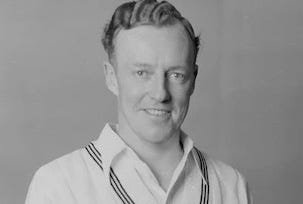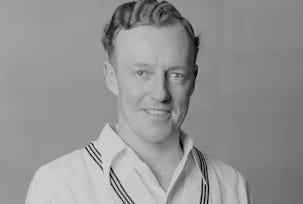Opportunities to excel in New Zealand's fragmented cricket structure during the Second World War years were few and far between, but among those who took their chances was Wellington's wicketkeeper and occasional batsman Frank Mooney.
Mooney debuted for Wellington at 21 in the 1941-42 season when playing for his province against Auckland.
Frank Mooney (Crown Studios Ltd :Negatives and prints. Ref: 1/2-191781-F. Alexander Turnbull Library, Wellington, New Zealand. /records/23209184)
But in his second game, also against Auckland at the Basin Reserve, which started on Christmas Day in 1943, as was common in that era, he pulled off a stunning performance that had interested fans sitting up and taking notice.
He had been out of form and was stumped for a duck in Wellington's first innings as they were out for 167 in reply to Auckland's 438. In their second innings, Wellington had struggled to 111-8 when Mooney, five not out, was joined by Bill Buchan, a right-arm fast-medium bowler.
In attempting to shelter his partner, Mooney only took scores from even numbers, twos, fours and sixes, until the last balls of overs, when some audacious singles were run.
They put on 127 runs in two hours. Buchan was trapped lbw when on 39 while Mooney was on 92. He was joined by former West Coaster 'Diddy' Knapp, who fans hoped would see him through to his century.
Knapp did better than that. He stayed until another 113 runs were posted, giving Auckland an hour to score 81 for the win. Mooney was the last man out when he succumbed from a hook shot with a score of 180. Knapp was 21 not out.
His ninth-wicket stand of 127 with Buchan and 113 with Knapp were New Zealand first-class records. They were also a world record because record partnerships for the ninth and 10th wickets in the same innings had never been achieved in a first-class game anywhere in the world.
Mooney's 180 was the highest score of his career and the first of two centuries. But it wasn't enough to deny Auckland, as they got home with five minutes to spare for the loss of two wickets. One of them was a young player named Sutcliffe, who dominated Auckland's first innings by scoring 144.
As a result of his effort, Mooney was included in a New Zealand XI against New Zealand Services at Wellington in March 1944.
He kept wickets for his side, which included Walter Hadlee (captain), Ian Cromb, Ken Uttley, Merv Wallace, Bert Sutcliffe, Tom Burtt and Jack Cowie, all of them New Zealand representatives at stages of their careers. As the Services side was dismissed for 99, the NZ XI responded with 233, 43 of them scored by Mooney. The game was drawn with the Services XI 147-8, with Mooney completing his second stumping and taking a catch, all of them from Burtt's bowling.
Mooney carried on in the summer of 1944-45 and was selected as wicketkeeper for the North Island. Tindill returned as captain in 1945-46, and he and Mooney opened the batting for the side with Mooney taking the gloves, apart from the game against the touring Australians where pre-war New Zealand representative and double All Black Eric Tindill kept.
Mooney did not play in the 1946-47 season and only twice the following season, one of the games being against the touring Fijian side.
The competition was hot among wicketkeepers for the 1949 tour to England, and after his lack of recent play, Mooney was regarded as a surprise selection for the tour when he was named ahead of Wellington favourite Tindill and Otago's George Mills.
"Before the season started, the new Wellington selector, Hugh Duncan, called both Eric and me into his office separately and told us that he couldn't separate us as wicketkeepers and batsmen, and said we would each have two games as wicketkeeper and would bat in the other two. [In fact, Mooney kept in each of Wellington's Plunket Shield games. He scored 198 runs at 49.50 while Tindill hit 225 at 45.0].
"That was how it went, and the panel selected me as the 12th man for both teams in the final New Zealand trial.
"I was told by Len Kent, who was in one of the trial teams as a wicketkeeper, that I would be asked to keep on the final morning.
"That's what eventuated. The selectors at the trial had asked each wicketkeeper to stand up, right over the stumps, to the bowlers. I was lucky because the ball was older when I was in, and I didn't make any mistakes.
"We came home on the Lyttelton ferry that Saturday night, and I spent Sunday morning pacing up and down the garden waiting for the team to be named at 12.30 pm.
"It was named alphabetically and when I heard the initials F H L, I let out a whoop. My initials are actually F L H, but I knew who they meant."[1]
It was on that tour he made his second century against the MCC at Lord's.
Mooney recounted to the Evening Post that the New Zealanders' top order had failed for the first time on their tour. They lost Hadlee, Martin Donnelly, and John Reid in 19 balls delivered by Trevor Bailey when Mooney was united with Geoff Rabone, scoring 94-6.
Digging in, they took New Zealand to 237-6 at stumps in reply to MCC's 379. Rabone was unbeaten on 74 and Mooney on 64. Not even a stoppage in play to allow King George VI to meet the tourists could break his concentration.
He and Rabone added 176 runs, and Mooney finished on 102. Rain ruined the final day with only 150 minutes of play possible. But in that time, Mooney completed his century before he was dismissed on 102 scored in 250 minutes, not bad for his first appearance at Lord's. Rabone was not so lucky, falling victim to off-spinner Jim Laker for 92.
He and Rabone added 176 runs, and Mooney finished on 102.
Their recovery in the drawn game made the British sit up and appreciate the side as one that was not reliant on two or three batters and who were outstanding in the field.
Mooney wasn't finished either. At Headingley, in the first Test, he was involved in a record 57-run stand for the last wicket with an ailing Jack Cowie. Cowie had Verdun Scott as a runner, and Mooney was able to score 46 before once again falling to Bailey. That record stood until the memorable stand by Nathan Astle and Danny Morrison at Eden Park in 1997, where their 102 runs scored in two hours and 45 minutes, defying England's bowlers, secured a drawn result in the first Test of the series. Astle scored 102 not out and Morrison 14 not out in what was his last Test.
Mooney told the Evening Post, "It was rather nice that it was broken that way. They played well. I watched 90 percent of their stand and it was lovely for Nathan Astle to get his 100.
"And Danny Morrison might be noted for making ducks, but he didn't look like scoring one yesterday. I'm just rapt in the whole thing. They looked beaten, but they weren't."
"Full marks to them both. I'm very pleased the record has been broken in that way."[1]
Back to Headingley. Just as exciting for Mooney was his feat, off the second ball of England's second innings, of catching Len Hutton off Harry Cave's bowling. Later in England's innings, he added Denis Compton to his record. He was also caught by Cave, who had stepped up with Cowie unable to bowl. England declared at 267-4, and by stumps on the final day, New Zealand was 195-2.
Mooney also toured South Africa on the 1953-54 tour and was a New Zealand selector for four seasons, including when a first Test victory over Australia was achieved in 1974 at Lancaster Park.
[1] Interview with Lynn McConnell, Evening Post, Wellington
[2] ibid



